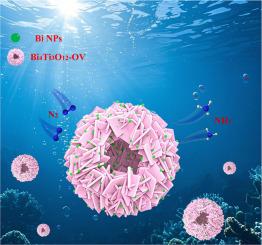氧空位和肖特基结协同工程增强太阳能驱动的分层中空Bi4Ti3O12固氮
IF 14.3
1区 材料科学
Q1 MATERIALS SCIENCE, MULTIDISCIPLINARY
引用次数: 0
摘要
由于氮气的活化困难和光生成载体的快速重组,开发高效的固氮光催化剂仍然是一个重大挑战。本文采用简单的水/溶剂热法制备了具有可调表面氧空位(OVs)的三维分层中空Bi/Bi4Ti3O12肖特基结光催化剂。由于表面OVs和Bi/Bi4Ti3O12界面上的Schottky结的协同作用,实现了高效的光利用,增强了光生载流子的分离和迁移。此外,肖特基结促进了从Bi4Ti3O12到金属Bi NPs的单向电子转移。富电子金属铋作为N2还原反应的活性位点。优化后的1% Bi/HBTO-OV3复合材料在无牺牲剂的情况下,在纯水条件下的氨产量为24.25 μmol g−1 h−1,是原始Bi4Ti3O12的5.66倍。原位实验和DFT计算阐明了光催化固氮机制,确认了N2加氢的关联远端途径。这项工作为设计高效光催化剂提供了一种合理的策略,通过将表面缺陷工程与肖特基结相结合,为可持续的太阳能驱动固氮铺平了道路。本文章由计算机程序翻译,如有差异,请以英文原文为准。

Synergistic engineering of oxygen vacancies and Schottky junctions for enhanced solar-driven nitrogen fixation on hierarchical hollow Bi4Ti3O12
Developing highly efficient photocatalysts for nitrogen fixation remains a significant challenge due to the difficult activation of N2 and rapid recombination of photogenerated carriers. Herein, 3D hierarchical hollow Bi/Bi4Ti3O12 Schottky junction photocatalysts with tunable surface oxygen vacancies (OVs) are fabricated by a facile hydro/solvothermal method. Due to the synergistic effect of surface OVs and the Schottky junctions at the Bi/Bi4Ti3O12 interface, efficient light utilization and enhanced separation and migration of photogenerated carriers are achieved. Additionally, the Schottky junctions facilitate unidirectional electron transfer from Bi4Ti3O12 to metallic Bi NPs. The electron-rich metallic Bi serves as the active sites for N2 reduction reaction. The optimized 1% Bi/HBTO-OV3 composite achieves an outstanding ammonia production rate of 24.25 μmol g−1 h−1 in pure water without sacrificial agents, which is 5.66 times higher than that of pristine Bi4Ti3O12. In situ experiments and DFT calculation elucidate the photocatalytic nitrogen fixation mechanism, confirming an associative distal pathway for the hydrogenation of N2. This work provides a rational strategy for designing high-efficiency photocatalysts by integrating surface defect engineering with Schottky junctions, paving the way for sustainable solar-driven nitrogen fixation.
求助全文
通过发布文献求助,成功后即可免费获取论文全文。
去求助
来源期刊

Journal of Materials Science & Technology
工程技术-材料科学:综合
CiteScore
20.00
自引率
11.00%
发文量
995
审稿时长
13 days
期刊介绍:
Journal of Materials Science & Technology strives to promote global collaboration in the field of materials science and technology. It primarily publishes original research papers, invited review articles, letters, research notes, and summaries of scientific achievements. The journal covers a wide range of materials science and technology topics, including metallic materials, inorganic nonmetallic materials, and composite materials.
 求助内容:
求助内容: 应助结果提醒方式:
应助结果提醒方式:


